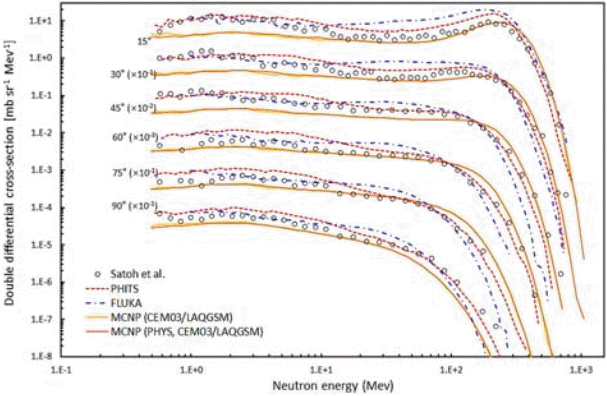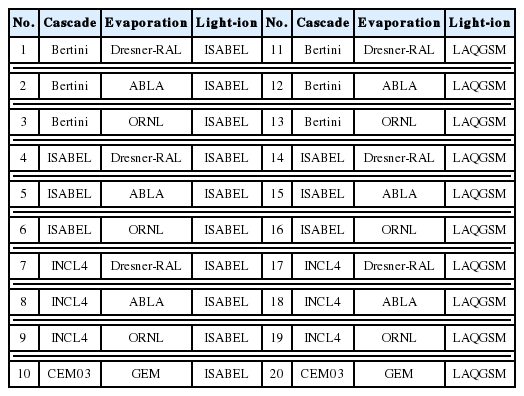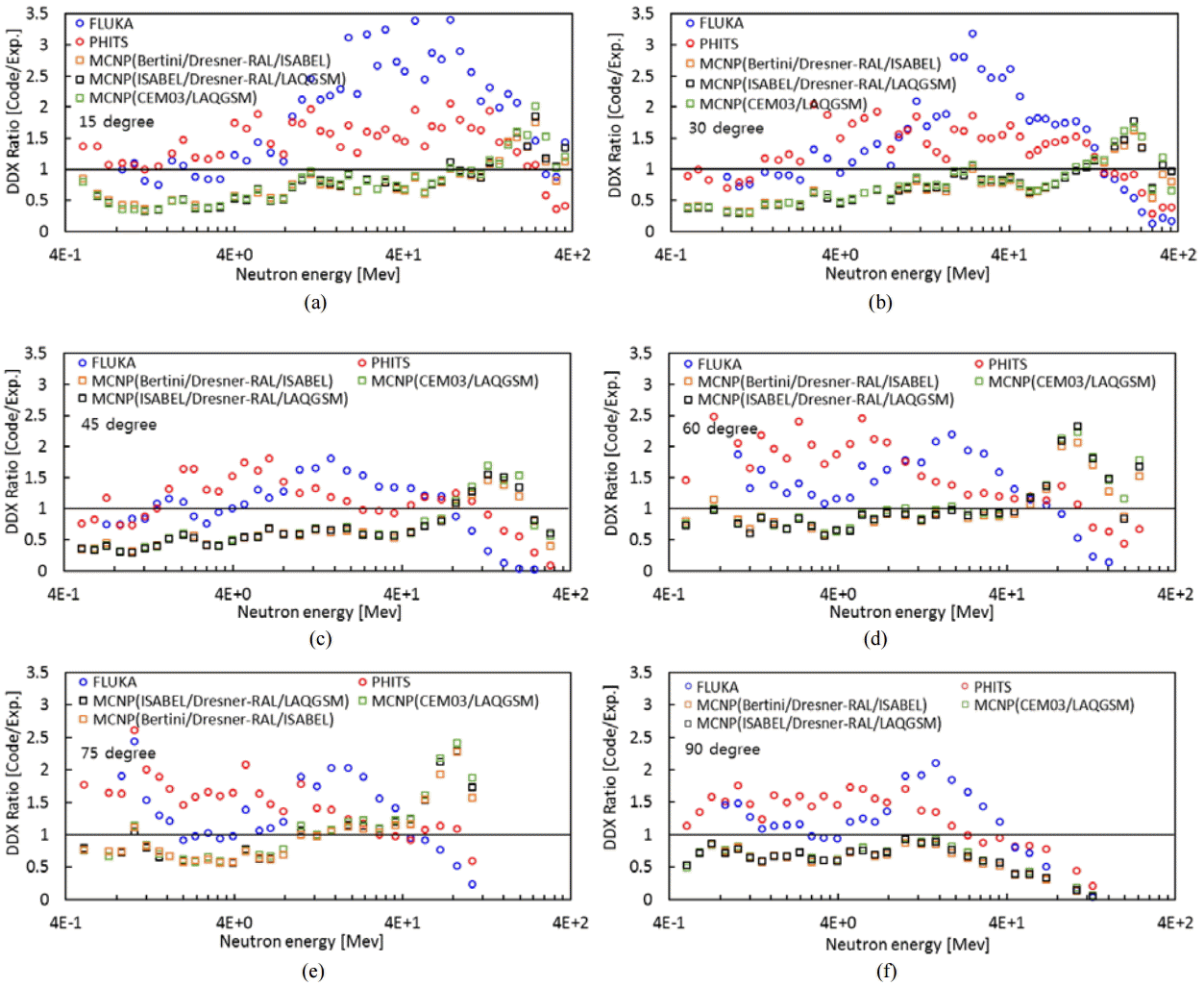Comparison of Physics Model for 600 MeV Protons and 290 MeV·n-1 Oxygen Ions on Carbon in MCNPX
Article information
Abstract
Background:
With the increase in the number of particle accelerator facilities under either operation or construction, the accurate calculation using Monte Carlo codes become more important in the shielding design and radiation safety evaluation of accelerator facilities.
Materials and Methods:
The calculations with different physics models were applied in both of cases: using only physics model and using the mix and match method of MCNPX code. The issued conditions were the interactions of 600 MeV proton and 290 MeV·n-1 oxygen with a carbon target. Both of cross-section libraries, JENDL High Energy File 2007 (JENDL/HE-2007) and LA150, were tested in this calculation. In the case of oxygen ion interactions, the calculation results using LAQGSM physics model and JENDL/HE-2007 library were compared with D. Satoh’s experimental data. Other Monte Carlo calculations using PHITS and FLUKA codes were also carried out for further benchmarking study.
Results and Discussion:
It was clearly found that the physics models, especially intra-nuclear cascade model, gave a great effect to determine proton-induced secondary neutron spectrum in MCNPX code. The variety of physics models related to heavy ion interactions did not make big difference on the secondary particle productions.
Conclusion:
The variations of secondary neutron spectra and particle transports depending on various physics models in MCNPX code were studied and the result of this study can be used for the shielding design and radiation safety evaluation.
1. INTRODUCTION
There are several accelerator facilities that are operating or under the construction in Korea. One of those facilities, a rare isotope accelerator (RAON), is now under the design. The RAON accelerator is designed to use heavy-ions such as 200-333 MeV·n-1 238U, 86Kr, 48Ca, and 16O for an IF target and 600 MeV protons for an ISOL target and the uSR facility1). With the increase in the number of particle accelerator facilities under either operation or construction, the accurate simulation using Monte Carlo codes become more important in the shielding design and radiation safety evaluation of accelerator facilities. The physics models which are used in Monte Carlo codes are critical factors to determine the secondary neutron production and the induced radioactivity of radiation shielding analysis.
In this study, the effect of physics models in the MCNPX 2.7.0 [1] was investigated using two cases of particle interactions using 600 MeV protons and 290 MeV·n-1 oxygen ions. Those comparisons were carried out with various combinations of physics models in order to determine the models that are appropriate for the source term evaluation and shielding performance analysis.
In case of oxygen ion projectile, the experiments performed by D. Sato et al. [2] were simulated. Additionally, the same calculations using the PHITS 2.6.4 [3] and FLUKA 2011.2b2)1) were carried out and compared with the experimental data and the calculated results using MCNPX code.
2. MATERIALS AND METHODS
2.1 Physics models in MCNPX
The particle spallation process is largely divided into two stages; (1) intra-nuclear cascade (INC) and (2) evaporation or fission. Then the nucleus gets de-excitation generating gamma-ray. The physics models affect these processes. Therefore, the secondary neutron spectra were compared by changing the physics models in MCNPX code for the hadron-nucleus interactions [4].
Using five cards (LCA, LCB, LCC, LEA, and LEB) of MCNPX input, the user can choose the physics model options. Setting for MCNPX physics model options consists of three parts related to spallation reactions; INC, fission-evaporation, and light-ion interactions. First, in the case of intra-nuclear cascade, Bertini [5], ISABEL [6], Intra-nuclear cascade code of liege (INCL4) [7], Cascade-exciton model (CEM) [8] version 03.03, and Los Alamos version of the quark gluon string model (LAQGSM)3),2) can be used. Second, for fission-evaporation, Dresner-RAL (Dresner evaporation model (associated with Rutherford Appleton laboratory fission by default)4),3), Abrasionablation model (ABLA) [9, 10], and Oak Ridge national laboratory (ORNL)5),4) model can be chosen. Third, ISABEL or LAQGSM can be selected as light-ion and nucleon physics modules. These can be selected with two cards of MCNPX input, which are LCA and LEA. The combinations of physics models in MCNPX 2.7.0 for each spallation reactions were illustrated in Figure 1.
The physics model, however, can be used for the simulation depending on type of projectile particle. If the incident particle is hadron (such as neutron and proton), Bertini, ISABEL, INCL4, and CEM03 INC model are available up to the upper energy limits of each models. For light-ions (deuteron, triton, 3He, and alpha according to MCNPX user’s manual), ISABEL and LAQGSM model are available for the calculation. In the case of heavy-ions, however, whose mass number is over 4, LAQGSM is the only model that can handle all heavy-ion interactions in MCNPX.
2.2 Simulation conditions using MCNPX
2.2.1 600 MeV protons on carbon
To simulate the incident protons on the carbon target using MCNPX 2.7.0, the 600 MeV proton beam and the disk shape of carbon target (Φ 100 cm×12 cm) were applied. The secondary neutron spectra were compared to investigate the effect of different physics models at four different scoring angles to the incident beam direction; 0-5 degrees, 30-45 degrees, 90-120 degrees, and 150-165 degrees. There are three calculation methods that can be selected by a user. First method is to use only physics models, second is the mix and match method, using cross-section library up to upper energy limits and using physics models above it, and setting to use only cross-section library on the simulation if it is available. We did those calculations in only two ways; using only physics models and using the mix and match method. The cross-section library applied in the mix and match method was JENDL/HE-2007 (~3 GeV) for neutron and LA150 (~150 MeV) for proton.
Setting input of the physics model options consists of INC model, fission-evaporation model, and light-ion and nucleon physics modules. With the three parts of options and all physics models, the twenty combinations of physics models were set up for the calculation. The twenty combinations are listed in Table 1. In the case of CEM03, unlike the other INC models, it is used with its own evaporation model, GEM. Only two combinations were made with the two different light-ion and nucleon physics modules, ISABEL and LAQGSM.
2.2.2 290 MeV·n-1 oxygen ions on carbon
At this benchmarking calculation, D. Satoh’s HIMAC experimental data and conditions were used: the beam was 290 MeV·n-1 oxygen ions and the size of carbon target was 5.0 cm×5.0 cm×1.5 cm (thickness) [2]. Six different scoring angles to the beam axis were 15 degrees, 30 degrees, 45 degrees, 60 degrees, 75 degrees, and 90 degrees. This calculation was also performed in two ways; using only physics models and using the mix and match method with the JENDL/HE-2007 for neutron and proton.
Even though the different physics models were applied, LAQGSM was used commonly, as the primary particle was heavy-ion. In this simulation, however, in order to compare the effects on the secondary particle transports or reactions depending on the physics models, the five combinations of physics models were made as shown in Table 2. Bertini, ISABEL and CEM03 models were used as INC model and Dresner-RAL model was used as fission-evaporation model. For the light-ion interactions, ISABEL and LAQGSM models were applied.
3. RESULTS AND DISCUSSION
3.1 600 MeV protons on carbon
These MCNPX simulations were performed with less than 1% of uncertainty. The different cascade physics models caused large different results in secondary neutron spectra when the condition of only physics models was applied. When the evaporation-fission model of Dresden-RAL and light-ion and nucleon physics modules of ISABEL were applied in common, the variations of secondary neutron spectra depending on different INC models (Bertini, ISABEL, INCL4 and CEM03) were obtained as shown in Figure 2. Other combinations with different fission-evaporation models and light-ion options also showed the same tendency of obtained spectra.

Comparison of secondary neutron spectra, depending on different INC models (using only physics models) at scoring angles; (a) 0-5 degrees, (b) 30-45 degrees, (c) 90-120 degrees, and (d) 150-165 degrees.
As can be seen at neutron spectra for 0 to 5 degrees in Fig. 2A, a peak was observed at lower neutron energy region when the CEM03 cascade model was applied and big wide peak was also found around 400 MeV. There was a hump around 3 MeV when the INCL4 model was applied. The neutron flux at high energy region was the highest with the Bertini model and was the lowest with the INCL4 model (Bertini>ISABEL>CEM03>INCL4). In the case of the neutron spectrum at 30 to 45 degrees in Fig. 2B, the similar peak within the INCL4 model was found again around 3 MeV.
Figure 3 shows the secondary neutron spectra when the mix and match method is applied. The tendency of spectra below 10 MeV had in a good agreement at all angles but some valley was appeared around 3 MeV in common. Above 10 MeV a large discrepancy was shown like the case of using only physics models. The phenomena were caused by the same cross-section libraries which were applied at the lower energy region.

Comparison of secondary neutron spectra, depending on different INC models (using mix and match method) at scoring angles; (a) 0-5 degrees, (b) 30-45 degrees, (c) 90-120 degrees, and (d) 150-165 degrees.
When the case of only physics models was applied, the discrepancy between secondary neutron spectra using different fission-evaporation models was negligible at every angles as shown in Figure 4. When the Bertini INC model and ISABEL model for handling the light-ion interactions were set up, a small discrepancy existed around 4 MeV.

Comparison of secondary neutron spectra, depending on different fission-evaporation models (using only physics models) at scoring angles; (a) 0-5 degrees, (b) 30-45 degrees, (c) 90-120 degrees, and (d) 150-165 degrees.
In the case of using the mix and match method, there was not big difference in secondary neutron spectra at all of scoring angles, depending on applied fission-evaporation model. Furthermore, as shown in Figure 5, the fission-evaporation model did not affect secondary neutron spectra in the conditions of different combinations of the INC model and the light-ion interactions.

Comparison of secondary neutron spectra, depending on different fission-evaporation models (using mix and match method) at scoring angles; (a) 0-5 degrees, (b) 30-45 degrees, (c) 90-120 degrees, and (d) 150-165 degrees.
Regarding the different physics models for light ion interactions, there was no discrepancy in secondary neutron spectra at the both cases of only physics models and the mix and match method as shown in Figures 6 and 7, respectively.

Comparison of secondary neutron spectra, depending on different light-ion and nucleon physics modules (using only physics model) at scoring angles; (a) 0-5 degrees, (b) 30-45 degrees, (c) 90-120 degrees, and (d) 150-165 degrees.
3.2 290 MeV·n-1 oxygen ions on carbon
This benchmarking calculation was also carried out with low uncertainty less than 1% at whole energy region. The differential neutron cross-sections calculated by the MCNPX code underestimated overall the experimental data reported by D. Satoh et al. whereas overestimated partly at high energy region. The effect of variation of different physics models was not found as shown in Fig. 8. The variation of physics models made insignificant effects on secondary particles produced from oxygen-induced reaction on carbon. In addition to the results of MCNPX calculations, two other well-known Monte Carlo codes, PHITS and FLUKA were used to calculate differential neutron cross-section and the comparison is shown in Fig. 9. The calculated cross-sections using three different Monte Carlo codes are in good agreements with the experimental data.

Comparison of differential neutron cross-section by 290 MeV·n-1 oxygen ions on the carbon target of experimental data and MCNPX results.

Comparison of differential neutron cross-section by 290 MeV·n-1 oxygen ions on the carbon target of experimental data and Monte
Figure 10 shows the C/E ratios of the calculated double differential cross-section to experimental data for 290 MeVn-1 oxygen ions on the carbon target. The MCNPX results were close to the experimental data at whole energy range but underestimated. In the FLUKA calculation, the C/E ratio around 40 MeV was relatively bigger than that of other energies. The calculated results using PHITS were found to overestimate normally. In those comparisons, the properties of three well-known Monte Carlo codes (MCNPX, PHITS, and FLUKA) were described apparently for the heavy-ion induced neutron production.
4. CONCLUSION
The comparison of secondary neutron spectra depending on physics models in MCNPX code were presented for the cases of 600 MeV protons and 290 MeV·n-1 oxygen ions irradiated to the carbon target. The calculations were carried out in two ways; using only physics models and using the mix and match methods.
In the simulation with 600 MeV protons on the carbon target, the INC model was important factor to determine secondary neutron spectra and its salient difference was found at high energy region and at 0 to 5 degrees. However, the effect due to different fission-evaporation models and physics models handling with light ion interactions made only the difference of about 5%. Therefore, the Bertini INC model could be applicable for the conservative shielding analysis at the forward direction.
On the contrary, in the case of incident heavy-ions, type of physics models in MCNPX code did not dominantly affect the neutron-production in oxygen-induced reaction on carbon. The effect on the secondary particle transport was not found too because the target size was relatively small to provoke some reactions on target. In other words, type of physics models is not major factor in the source term evaluation for heavy-ions. In the case of PHITS and FLUKA calculation, the results were relatively in a good agreement with the experimental data but overestimated by the factor of three at limited energy range around 40 MeV.
Acknowledgements
This work was supported by the Nuclear Safety Research Program through the Korea Radiation Safety Foundation (KORSAFe) and the Nuclear Safety and Security Commission (NSSC), Republic of Korea (Grant No. 1303026).
Notes
Rare Isotope Science Project. Baseline design Summary. http://risp.ibs.re.kr/eng/orginfo/info_blds.do
Ferrari A, Sala PR, Fasso A, Ranft J. FLUKA: a multi-particle transport code. CERN-2005-10, INFN/TC_05/11, SLAC-R-773. 2005.
Gudima KK, Mashnik SG, Sierk AJ. User manual for the code LAQGSM, Los Alamos national laboratory report. LA-UR-01-6804. 2001.
Dresner L. EVAP—A Fortran program for calculating the evaporation of various particles from excited compound nuclei. ORNLTM-196. 1961.
Barish J, Gabriel TA, Alsmiller FS, Alsmiller RG, Jr. HETFIS: High-energy nucleon-meson transport code with fission. Oak Ridge National Laboratory. ORNL/TM-7882. 1981.




